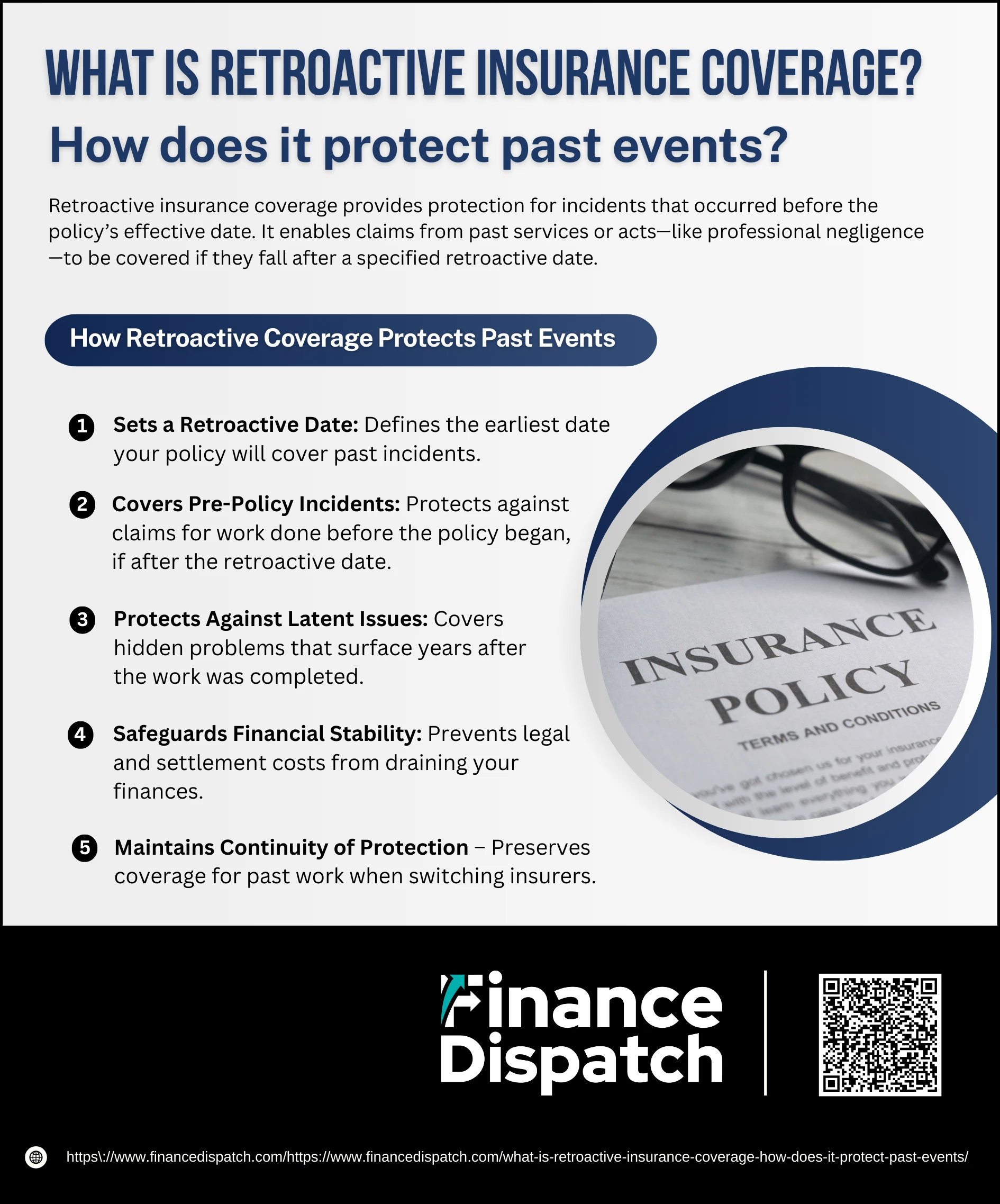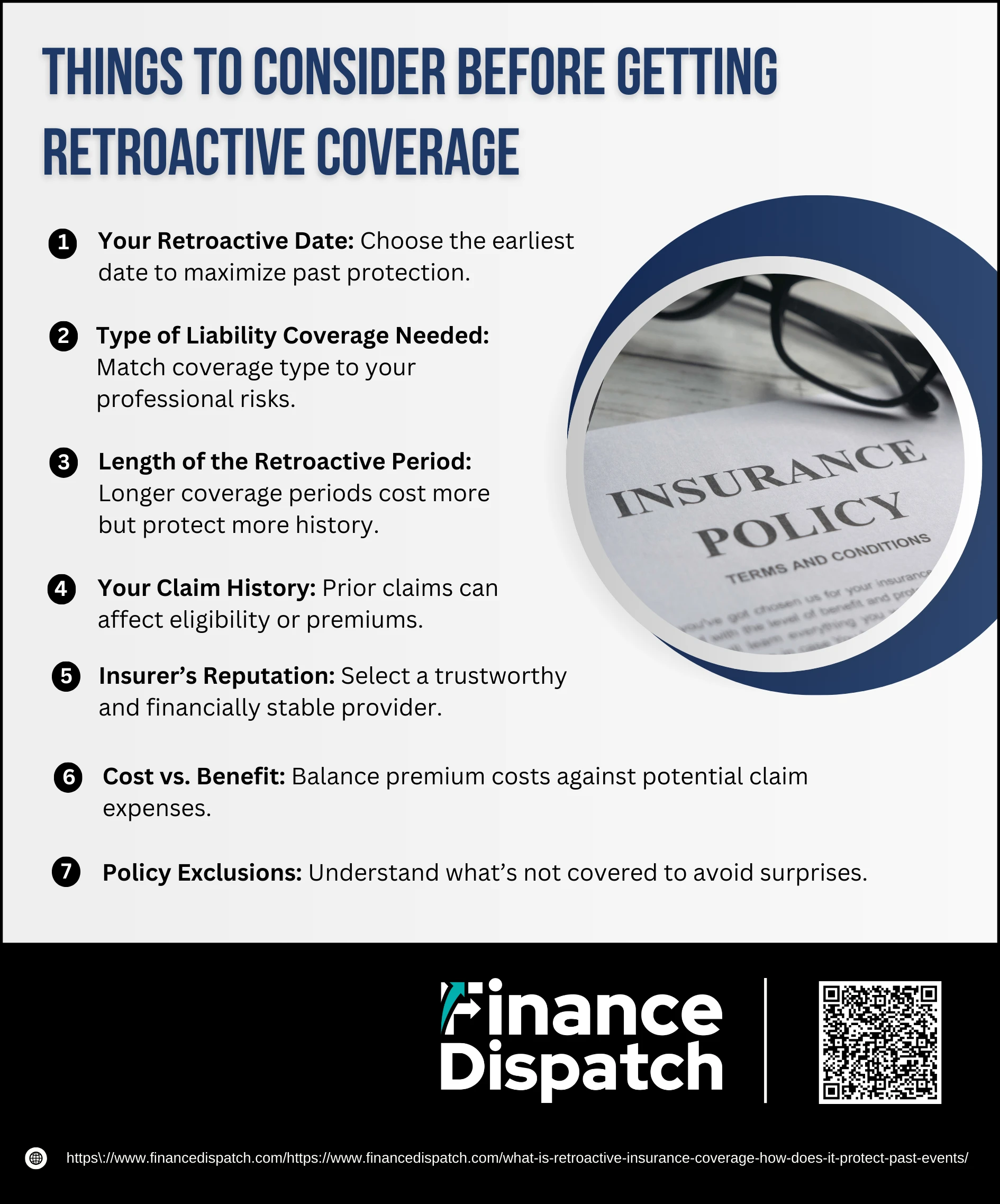When it comes to protecting your business or professional practice, insurance is often seen as a safeguard for future risks—but what about mistakes or incidents from the past that haven’t surfaced yet? Retroactive insurance coverage steps in to fill that gap. It’s a special feature in certain liability policies that covers claims arising from work you did before the policy’s start date, as long as they fall within the agreed retroactive period. This means that if a client discovers an error, a defect, or another issue years after you completed the job, you could still be protected from costly legal fees and compensation payouts. In essence, retroactive coverage acts as a safety net for your history, ensuring past events don’t jeopardize your present financial stability.
What is Retroactive Insurance Coverage?
Retroactive insurance coverage—also known as prior acts coverage—is a provision in certain liability insurance policies that protects you against claims for incidents that happened before your policy officially began. Unlike standard coverage, which only applies to events occurring after the policy’s start date, retroactive coverage reaches back to a specified retroactive date. Any qualifying claim made during your active policy period for work performed after that date can be covered, even if the work was completed months or years earlier. This is particularly important in professions where issues may not surface right away—such as accounting errors, construction defects, or medical oversights—helping to shield you from financial loss, legal costs, and reputational damage stemming from your past work.
 How Retroactive Coverage Protects Past Events
How Retroactive Coverage Protects Past Events
Retroactive coverage is designed to protect you from claims tied to your past work—especially in fields where mistakes or damages may not be discovered until years later. Without it, you could face costly legal bills and compensation demands for incidents that occurred long before your current insurance policy began. Here’s how each part of this coverage works:
1. Sets a Retroactive Date
Every retroactive coverage policy starts with a specific date—known as the retroactive date. This date determines how far back in time the policy will protect you. Any incident that happened before this date won’t be covered, but anything after it can be, provided the claim is made during the active policy. For example, if your retroactive date is January 1, 2018, your policy could cover a claim in 2025 for work completed in 2019.
2. Covers Pre-Policy Incidents
The main advantage of retroactive coverage is its ability to include incidents that happened before your current policy started. So, if you performed a service in 2021, purchased a policy in 2023, and a client files a claim in 2024 for that 2021 work, you could still be covered—provided the event occurred after your retroactive date and meets policy terms.
3. Protects Against Latent Issues
Many industries face “latent” problems—issues that remain hidden until long after a job is done. Examples include a construction defect that appears years later, a bookkeeping error only found during a tax audit, or a medical oversight discovered well after treatment. Retroactive coverage ensures these delayed issues are still within your protective shield.
4. Safeguards Financial Stability
Defending against a claim isn’t just about paying compensation—it often involves expensive legal representation, investigation, and sometimes settlement negotiations. Retroactive coverage absorbs these financial hits, preventing them from draining your business savings or personal assets. Without it, even one large claim could cause serious financial harm.
5. Maintains Continuity of Protection
Gaps in coverage are a major risk, especially when switching insurance providers. If you move from one insurer to another without maintaining your retroactive date, you could lose protection for past work. Retroactive coverage allows you to carry that date forward, ensuring seamless protection and no vulnerable periods in your insurance history.
Why Businesses and Individuals Choose Retroactive Coverage
Retroactive coverage isn’t just an insurance add-on—it’s a strategic safety net that protects your financial future from past risks. Whether you’re running a business or working as an independent professional, mistakes and oversights can stay hidden for years before turning into costly claims. By including retroactive protection in your policy, you gain peace of mind knowing that your history is covered as securely as your present.
1. Covers Past Work – Ensures that services or projects completed before your policy start date are still protected if a claim arises.
2. Bridges Insurance Gaps – Maintains protection even if there was a lapse in your coverage or a change in insurance providers.
3. Addresses Latent Risks – Protects against hidden issues, such as construction defects or accounting errors, that surface long after the job is done.
4. Supports Career Transitions – Allows professionals changing employers or starting a new practice to carry coverage for their prior work.
5. Preserves Financial Stability – Helps cover legal fees, settlements, and compensation costs from past incidents, preventing personal or business financial strain.
6. Maintains Reputation – Shields your professional image by ensuring claims from past work are handled quickly and effectively through insurance.
Real-World Examples of Retroactive Coverage
Retroactive coverage becomes most valuable when past actions, long forgotten, resurface as legal or financial liabilities. These situations often arise unexpectedly, catching businesses and professionals off guard. By having a retroactive clause in place, policyholders can respond to these claims without bearing the full cost themselves. Here are some practical scenarios where retroactive coverage makes all the difference:
1. Construction Defect Discovered Years Later – A contractor completes a building in 2019, but structural issues appear in 2023. With retroactive coverage dating back to 2018, the insurer covers repair and legal costs.
2. Accounting Error Found During Audit – An accountant files a client’s taxes in 2021. In 2024, an audit uncovers a miscalculation that results in penalties. Retroactive coverage ensures the accountant’s legal and settlement expenses are paid.
3. Medical Oversight from a Prior Practice – A doctor changes clinics in 2025, but a patient sues over a missed diagnosis from 2022. A retroactive clause in the new malpractice policy covers the claim.
4. Engineering Miscalculation on a Past Project – An engineer’s bridge design from 2018 is found to have a flaw in 2024. The retroactive date on their policy ensures the incident is covered.
5. IT Security Breach from Previous Work – A cybersecurity consultant moves to a new client in 2023, but an old client suffers a data breach in 2024 linked to work from 2021. Retroactive coverage protects against the claim.
Common Industries Using Retroactive Coverage
Retroactive coverage is widely used in professions where the impact of mistakes, omissions, or defects might not surface until years after the work is completed. These industries often deal with complex projects, legal obligations, or safety concerns that carry long-tail risks—meaning claims can arise well after the job is finished. By including retroactive protection in their policies, professionals in these fields safeguard both their finances and their reputations.
1. Construction & Engineering – Covers claims for structural defects, design flaws, or project miscalculations discovered years later.
2. Accounting & Financial Services – Protects against errors in tax filings, audits, or investment advice that lead to future losses.
3. Healthcare & Medical Professions – Includes malpractice coverage for missed diagnoses, treatment errors, or other oversights from past patient care.
4. Legal Services – Shields lawyers from claims over drafting errors, missed deadlines, or advice given in previous cases.
5. IT & Cybersecurity – Covers liabilities from software bugs, configuration errors, or security gaps identified long after project completion.
6. Architecture & Design – Protects against claims for faulty plans or specifications that cause costly construction issues later on.
Pros and Cons of Retroactive Insurance Coverage
Retroactive insurance coverage can be a game-changer for professionals and businesses, especially in industries where liabilities may surface years after the work is done. However, while it offers broad protection, it’s not without its trade-offs. Below is a closer look at the main benefits and limitations to help you make an informed decision.
1. Pro – Protection for Past Work
This is the primary benefit. Retroactive coverage allows you to insure work completed before your current policy began, as long as it falls within the retroactive date. For example, if you designed a building in 2019, bought a policy in 2023 with a retroactive date of January 1, 2018, and a claim arises in 2024 for a design flaw, your insurer can still respond. Without this feature, you’d be on your own financially.
2. Pro – Financial Security
Defending against a claim—whether valid or not—can be expensive. Retroactive coverage covers legal fees, expert witness costs, settlements, and potential damages. This protection ensures that a single old claim won’t drain your business funds or personal savings. For many, it’s the difference between surviving a lawsuit and facing bankruptcy.
3. Pro – Prevents Coverage Gaps
When you change insurers or miss a renewal deadline, there’s a risk of losing protection for past work. By preserving your retroactive date when you start a new policy, you maintain seamless coverage history. This is especially important for professionals who switch jobs, merge firms, or take career breaks but still face liability from previous work.
4. Con – Higher Premium Costs
The more history you cover, the more potential exposure your insurer takes on—so the cost rises. Full retroactive coverage, which goes back to the start of your career or business, will generally have higher premiums than limited retroactive coverage. For small businesses or solo practitioners, the added cost can be a significant budget consideration.
5. Con – Limited by Retroactive Date
Your retroactive date acts like a cut-off line. Anything that happened before that date is automatically excluded, even if the claim is made while your policy is active. This means you need to set the date as far back as possible—ideally to when you first started work—to maximize protection.
6. Con – Potential Exclusions
Even with retroactive coverage, not every claim will be covered. Policies typically exclude intentional acts, criminal activity, or issues you already knew about before buying the policy. For example, if you were aware of a client complaint from two years ago and only bought coverage now, the insurer is unlikely to cover it.
 Things to Consider Before Getting Retroactive Coverage
Things to Consider Before Getting Retroactive Coverage
Retroactive coverage can be a valuable safeguard for your past work, but getting the most from it means carefully reviewing the details before you commit. The right policy can protect you from costly claims, while the wrong one might leave you paying out of pocket for issues you thought were covered. Below are key factors to keep in mind before you buy.
1. Your Retroactive Date
This date determines how far back in time your coverage applies. Choosing the earliest possible date—ideally when you started your business or career—offers the broadest protection. Any incident before this date will not be covered, no matter when the claim is made.
2. Type of Liability Coverage Needed
Not all retroactive policies are the same. For example, a consultant may need professional liability coverage, while a manufacturer might require product liability. Matching the coverage type to your actual risks ensures your policy will respond to the right kinds of claims.
3. Length of the Retroactive Period
A longer retroactive period means more historical work is covered, but it often comes with a higher premium. You’ll need to weigh whether the added protection justifies the cost based on your industry and claim exposure.
4. Your Claim History
If you’ve had prior claims or are aware of potential issues, some insurers may exclude these from coverage or raise your premium. Full disclosure is important, as hiding known risks could void your policy later.
5. Insurer’s Reputation
A policy is only as good as the company behind it. Look for an insurer with a strong record of fair claim handling, responsive customer service, and solid financial stability. Reading reviews and seeking recommendations can help you avoid future frustrations.
6. Cost vs. Benefit
While retroactive coverage can be more expensive than standard policies, the cost should be weighed against the potential financial losses from an uncovered claim. In many cases, a single lawsuit could far exceed years of premium payments.
7. Policy Exclusions
Even with a generous retroactive date, there will be limits. Common exclusions include intentional acts, criminal conduct, or claims you were already aware of before buying the policy. Review these carefully so there are no surprises when you file a claim.
Conclusion
Retroactive insurance coverage is more than just an optional add-on—it’s a strategic safeguard that bridges the gap between your past work and your current protection. By covering incidents that occurred before your policy’s start date, it ensures that hidden errors, overlooked issues, or delayed claims don’t turn into financial or reputational disasters. Whether you’re a business owner, an independent professional, or someone switching insurers, understanding your retroactive date, policy terms, and coverage limits is essential. With the right plan in place, you can move forward confidently, knowing your history is as well-protected as your future.



